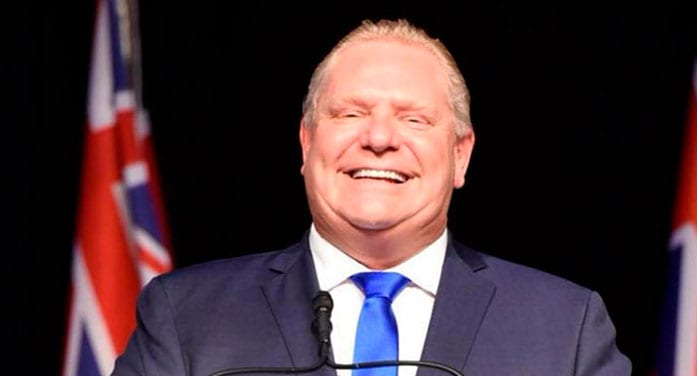 Ontario Premier Doug Ford and the Progressive Conservatives were triumphant in the June 2 election. That hasn’t stopped their critics and opponents from pouring cold water on this impressive victory for something not of their own making.
Ontario Premier Doug Ford and the Progressive Conservatives were triumphant in the June 2 election. That hasn’t stopped their critics and opponents from pouring cold water on this impressive victory for something not of their own making.
The PCs won 40.82 per cent of the vote and 83 of the 124 contested seats. This was a slight 0.32 per cent increase in popular support from the 2018 election but a large increase of 16 seats from the dissolution of the Ontario legislature.
Andrea Horwath’s NDP remained the official opposition, winning 31 seats (down from 38) and 23.74 per cent support (down from 33.59 per cent in 2018). Steven Del Duca’s Liberals ended up with eight seats (up one seat) and 23.85 per cent support (up from 19.59 per cent in 2018) but didn’t meet the threshold of official party status. Mike Schreiner’s Green Party held on to its one seat and earned 5.96 per cent support (up from 4.6 per cent). The two small right-leaning parties, New Blue Party of Ontario and the Ontario Party, lost their seats and earned 2.72 per cent and 1.8 per cent support, respectively.
| RELATED CONTENT | |
| Ontario land use policies make housing unaffordable By Wendell Cox |
|
| What Alberta conservatives may not learn from Ford By Doug Firby |
|
| Ontario taxpayers set to choose from three unpalatable options By Jay Goldberg |
|
|
Horwath and Del Duca announced their pending resignations as party leaders on election night. They represent casualties of Ford’s massive victory in some eyes.
But many Ontario progressives immediately started to moan, complain and make every excuse in the book for the mediocre performances of their left-leaning parties. In particular, they focused on low voter turnout.
Elections Ontario’s preliminary evaluation suggested that 43.5 per cent of eligible voters performed their civic duty on June 2. Roughly 4.6 million votes were cast out of the slightly more than 10.7 million registered voters. It’s the lowest recorded voter turnout in provincial history. The previous low was 48.2 per cent in 2011.
Several political commentators and columnists broke down this modest number even further. The Globe and Mail’s Andrew Coyne, for instance, tweeted a pie chart on June 3 that noted the PCs received 18 per cent, Liberals 10 per cent, NDP 10 per cent and other parties five per cent of eligible votes with this low turnout.
While these numbers are valid, so what?
Voter turnout was low, but the name of the game is GOTV: get out the vote. You can’t control how many people ultimately vote, but you can motivate your supporters to vote. Ford and the PCs did it best and that’s why they won.
Why didn’t people turn out to vote?
There are several possibilities:
- Voter apathy.
- Frustration with all political parties.
- Former NDP and Liberal supporters found nothing of value in either Horwath or Del Duca’s leadership, and refused to vote PC, Green or otherwise.
- General contentment with the PC government, combined with an early realization that Ford would win handily.
- No desire for political change.
Is there a way to encourage higher voter turnout? What about reforming Ontario’s electoral system, for instance?
Ontario uses the first-past-the-post (FPTP) model. An individual running in an electoral district can win a legislative seat by as little as one vote or as many as, say, one million votes. The latter wouldn’t occur in any Canadian province, but you get the general idea.
I’m not a huge fan of FPTP. There are different electoral models that I believe would produce results that are more fair and more representative of voters’ actual intentions. This includes alternative vote/instant runoff voting (used in Australia, Ireland and India) and mixed-member proportional representation (used in New Zealand, Bolivia, Germany’s Bundestag and several state elections). I even briefly supported the implementation of mandatory voting but quickly returned to the side of electoral reform.
At the same time, I’m not wildly opposed to FPTP. It’s an imperfect electoral system that discounts popular support, but does produce a clear number of winners and losers in the total seat count. There are no popular thresholds to be met for party representation in a legislature, either.
That’s why Canada’s two main parties, the Liberals and Conservatives, have historically favoured a majoritarian electoral system while the NDP, Greens and smaller parties haven’t. The electoral process works mostly to the former’s political advantage. If it ain’t broke, why fix it?
It’s also important to keep in mind that the four political parties that have governed Ontario – PCs, Liberals, NDP and now-defunct United Farmers of Ontario – were all elected under FPTP. There have also been MPPs elected under smaller party banners, including Labour-Progressives, Patrons of Industry and Soldier Party, as well as various independents.
Ford and the PCs overwhelmingly won the support of Ontarians who voted. The intangibles are what they are. Making excuses for them doesn’t excuse the fact that the NDP, Liberals, Greens and others failed to attract widespread interest and voter support. Their complaints are nothing more than sour grapes.
Michael Taube, a Troy Media syndicated columnist and Washington Times contributor, was a speechwriter for former prime minister Stephen Harper. He holds a master’s degree in comparative politics from the London School of Economics. For interview requests, click here.
The opinions expressed by our columnists and contributors are theirs alone and do not inherently or expressly reflect the views of our publication.
© Troy Media
Troy Media is an editorial content provider to media outlets and its own hosted community news outlets across Canada.
